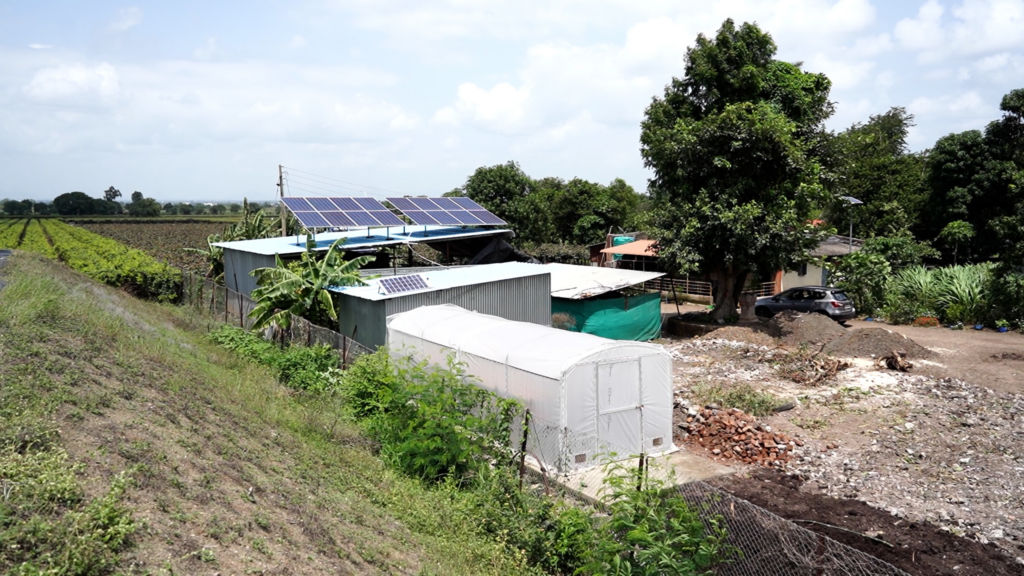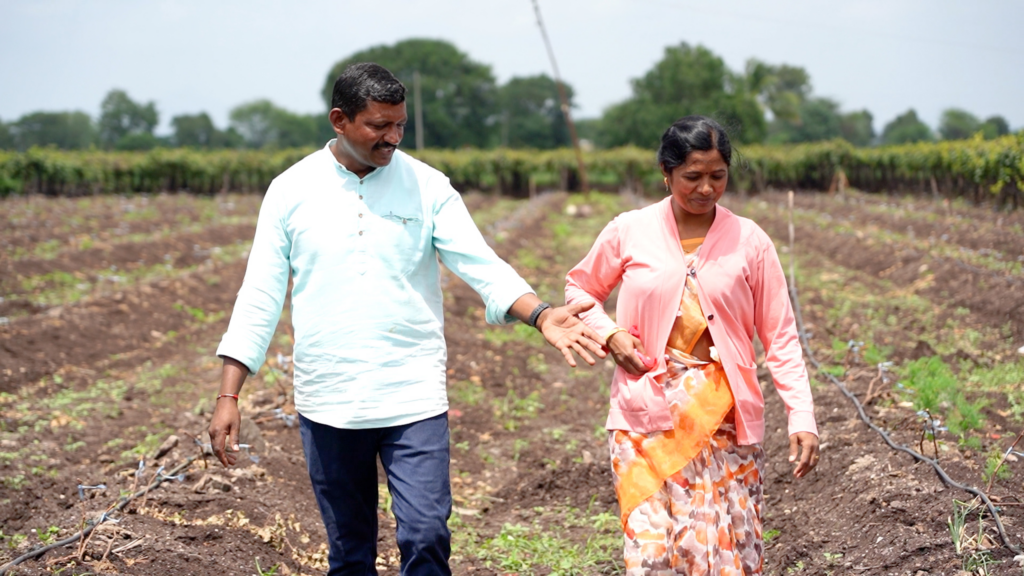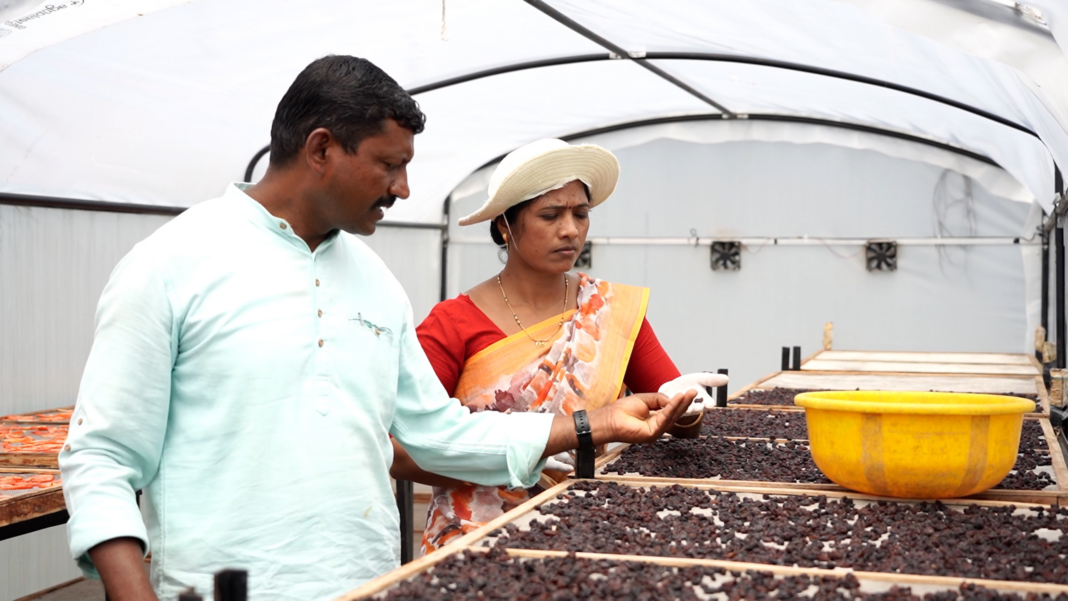Solar dryers help Indian farmers increase their incomes and reduce food waste.
On a warm November afternoon, a gentle breeze blows through the vineyard in front of the Jadhavs’ house in Pimpri, a village in the western Indian state of Maharashtra. The vines are heavy with bright green grapes. Farmer Vasudha Jadhav takes off her shoes before entering a white, tunnel-shaped greenhouse. She checks on the sliced tomatoes placed on mesh trays along the shelves of a solar dryer — one of five that the Jadhavs own.
The Jadhavs installed their first solar dryer in January 2023, but not before they lost a considerable part of the harvest of the black grapes they grow on their eight-acre farm. When it rained for three days, the grapes cracked, lowering their quality, and therefore their value. The couple sold most of the crop at a loss. They had, however, put some in their new solar dryer, saving 700 kilos of dried grapes and earning them a profit. “When untimely rain ruins the harvest, or overproduction causes the demand to drop,” Vasudha explains, “we [used to] leave the crops in the field to rot. Solar dryers can save them.” Last year, the couple also solar dried onions, tomatoes, coriander, and fenugreek.

A solar dryer consists of a steel frame with a curved roof covered with white polycarbonate sheeting. The structure stands on ground layered with reinforced concrete cement. The temperature inside can reach up to 122 °F, and exhaust fans at the front and the back regulate the flow of hot air. Food dries on trays made with a mesh wire base and placed on three-tiered shelving. A small, 120-watt solar panel powers the dryer, which can process up to 500 kilos of produce in a single cycle (roughly 12 days for drying grapes into raisins; time varies for other foods).
Solar dried food tends to be of higher quality than sun dried (dried in the open in direct sunlight). Sun dried raisins, for instance, tend to have burnt skins and are exposed to outdoor elements like dust and pests, which lowers their quality. Higher grade solar dried raisins sell at five times the price of their sun dried counterparts.
The Jadhavs first learned about solar drying from Sahyadri Farmers’ Producer Company, also known as Sahyadri Farms, which works with 24,000 farmers in the state. “There should be an alternate source of income for farmers who face losses due to climate impacts. If there is a price fluctuation, a farmer can rely on food processing as a backup plan. Solar drying can create value addition,” says Suresh Nakhate, PR manager at Sahyadri Farms.
Sahyadri connected the Jadhavs to Raheja Solar Food Processing (RSFP) in Indore in central India, which has been assembling low-cost solar dryers since 2016. RSFP installs solar dryers on farms and also buys back dried produce and resells it to food manufacturing companies. To date, it has installed 4,000 dryers across India.

The Jadhavs were able to afford their first dryer because of a grant they received from a nonprofit organization called Sustain Plus. At that time, the dryer cost $1,871; the $1,200 the Jadhavs received from Sustain Plus grant covered the bulk of the cost. This year, the Jadhavs sold their solar dried produce to RSFP and to fruit vendors in cities. In November, they took advantage of a government subsidy and a bank loan to buy four additional dryers.
Food waste is a serious global issue and contributes to climate change. In India, food waste mostly occurs at the farm level. Climate impacts such as erratic rainfall and high temperatures are increasingly damaging crops. Overproduction of popular crops like tomatoes can make their price dip drastically, or there can be strikes, leaving farmers with a crop they can’t get to market or one that’s not worth getting to market. In such situations, farmers dump their harvest by the roadside or leave it to rot in their fields, because many villages in India lack a proper waste management system.
Solar drying fruits and vegetables uses clean energy to prevent the problem of agricultural waste. Solar dried foods fetch better prices for farmers, since solar drying keeps food safe from dust and pests and allows it to retain its color, taste and nutritional value.
According to a recent report by Indian think tank Council on Energy, Environment and Water (CEEW), there are currently 8,000 solar dryers in India. While this is generally good news as regards reducing food waste, like any technology, solar dryers come with their limitations. Eight-five percent of Indian farmers have small farms, and a solar dryer (which now costs $2,664) can be an expensive investment. Also, the technology doesn't work during monsoon season, which generally lasts from June to mid-September. “We can't use the dryer in the rainy season because moisture can attract fungus,” says Vasudha Jadhave’s husband Dattatray.
“Complaints are rare,” says Devshree Gupta, marketing and farmer relationships head at RSFP, though she admits that sometimes the exhaust fans fail and notes that there have been cases of monkeys tearing down the polycarbonate sheeting. Also, ironically, solar dryers, which protect farmers from the vicissitudes of climate change, can also get damaged by the extreme weather events that are now more frequent due to the climate crisis. This year, when a cyclone in Gujarat damaged the solar dryers on some farms, RSFP had to send a repair team to the state.
Despite solar dryers’ limitations, the Jadhavs say that they now spend less than half the time they used to on drying grapes in the open, a process that used to take twenty to twenty-five days. They no longer need to dip grapes in antifungal oil, nor do they have to turn the grapes every couple of days or check on them several times a day to protect them from dust, bird droppings, and stray dogs. In 2022, they sold two tons of sun dried raisins at the rate of sixty cents a kilo, earning a profit of $625. In 2023, they sold 750 kilos of solar dried grapes at the rate of $4.50 a kilo, earning a profit of $2,418. In other words, the couple sold less after the arrival of the solar dryer and made nearly four times more money.
The Jadhavs are proud to produce high-quality, safe, and hygienic produce. “Climate change is not in our hands, but we can try to reduce pollution by using solar energy,” Dattatray says. What’s more, he adds, “now I am reassured that I will be able to earn more for whatever I grow, despite the weather conditions.”





